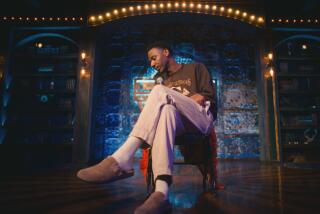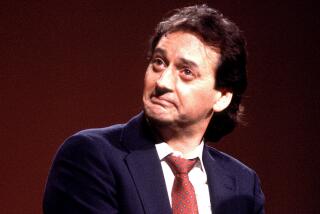George Carlin’s comedy ‘stuff’ finds new homes in a DVD anthology — and in a museum
The late, influential comic George Carlin once told The Times that the three ingredients that made up his comedy were “English language and wordplay; secondly, mundane, everyday observational comedy — dogs, cats and all of that stuff; and thirdly, sociopolitical attitude comedy.”
One of his most famous routines, “A Place for My Stuff,” definitely falls into the second category.
“That’s all I want, that’s all you need in life, is a little place for your stuff, ya know? I can see it on your table, everybody’s got a little place for their stuff. This is my stuff, that’s your stuff, that’ll be his stuff over there.”
Carlin, who died at the age of 71 on June 22, 2008, had plenty of stuff. And he took great care of all of it — especially his joke files.
“He would write down a word, a phrase, a statistic, an idea, a premise and a punchline and would write them on whatever was handy — hotel paper, scripts of note cards or journal pages,” said Carlin archivist Logan Heftel.
Now some of the comic’s greatest “stuff” is being released by MPI Home Video in the “George Carlin: Commemorative Collection.” It features all 14 of his HBO specials from his 1977 “On Location With George Carlin” that was taped at USC to 2008’s “It’s Bad for Ya,” which aired just three months before his death.
There are also bonus features such as his appearances on 1963’s “CBS Talent Scouts”; 1966 and 1967 gigs on ABC’s “The Hollywood Palace” and 1969’s “The Jackie Gleason Show,” when he was a clean-cut popular comic best known for his character Al Sleet, the Hippy-Dippy Weatherman.
Also included are 1973’s “The Real George Carlin” his only mainstream network special, which featured his new counterculture persona replete with long hair and beard and hip comedy.
His daughter, Kelly Carlin, has donated her father’s archive to the new National Comedy Center in Jamestown, N.Y. — the hometown of Lucille Ball — which opens Aug. 1. There will be a permanent Carlin exhibit there.
“It’s multimedia and representative of the collection that he saved, and they are now restoring,” said Heftel. “So, you’ll see everything from selections of his shows to interviews with many current comedians talking about his influence and a lot about his impact on language on broadcasting with the seven dirty words and the FCC Supreme Court case.”
Carlin collected all of this material, said Heftel, “and classified them in different categories in Ziploc baggies.”
When he died, Carlin left one complete storage unit of his career stuff. “It was all laid out on shelving very carefully,” said his daughter. “He had these big steamer trunks. It was very clear that he was getting his things in order for those last few years.”
He took special care of the audio recordings of his concerts, including one from Summerfest, “where he got arrested in Milwaukee for language in ’72,” his daughter recalled.
Kelly Carlin noted that her father was “dying inside” with his 1960s clean-cut persona. “He dropped acid in ’69. It really changed everything for him. He was really feeling hog-tied by it all and after getting fired in Vegas for saying ‘expletive’ on stage.”
He finally told her mother, Brenda, that he couldn’t do it anymore. “ ‘I have to be who I really am and do this differently and it’s going to mean starting over. Who knows if we’re gonna get anywhere.’ My mom was like ‘Let’s do it.’ We moved from a rental in Beverly Hills to an apartment in Venice Beach when Venice Beach was bikers, junkies. I wasn’t allowed to go trick-or-treating. It was a huge risk, but it paid off right away for him.”
Carlin kept evolving over the years. “He wasn’t just an entertainer, he was an artist,” said his daughter. “Artists have their periods. What’s my comfort zone? Where can I stretch out a bit?”
In the late ’80s, Carlin’s comedy took on more of an acerbic, angry tone.
“I think it was just a natural part of who he was,” Kelly Carlin noted. “In the late ’80s, we’d all gone through the Reagan era and the world had changed a lot. The promise of the ’60s was over and the yuppies had sold out. This was the broken bighearted idealistic coming out and saying, ‘OK, well I guess we’re not doing that anymore, so I better point out the way in which we’ve sold our souls to the devil.’ ”
Comic/actor Patton Oswalt, who wrote the liner notes for the DVD set, had been a fan since seeing Carlin as a guest on “Sesame Street.” Oswalt recalled seeing a show Carlin gave in the 1980s in Washington, D.C., that reflected his changing persona.
“He was kind of in between being the comic from the ’70s and the Carlin from the ’90s where it was almost like weirdness for weirdness’ sake,” Oswalt said. “He was sort of lost in the wilderness for a while. He hadn’t gotten that anger that he had in the ’90s. It was interesting to see him in mid-transformation.”
Comic Lewis Black, who cites Carlin as one of his major influences, said he was “the kind of guy that you listen to and went, ‘Oh wow, I’m glad somebody’s saying this.’ He’s the one who made you feel less crazy. There were certain books that did it. [Joseph] Heller did it. [Kurt] Vonnegut did it. Carlin did it. He was the adult who was actually going, ‘Hey, it’s nuts. It’s nuts. You’re not crazy.’ ”
Also, Black noted, “You watched his transition. I hate this word, but he was iconic in the sense of making the transition from straight to whatever. You watched his transformation from ‘I’m not going to be like this anymore.’ He culturally transitioned in the same fashion many of us did.”
Carlin, said his daughter, felt “weird about his intellectual property being out in the world,” on YouTube and other social media outlets before his death. “He wanted to protect it, but then once he died we kind of just let it be what it was — let people put up stuff because I wanted people to discover him.
“I get emails and messages on Facebook and Twitter from people from Pakistan, India, China and Africa who are blown away by him. He didn’t have an international presence [when he was alive]. And it’s really opened him to a younger generation. Of course, people who are fans are teaching their kids about him.”
More to Read
Only good movies
Get the Indie Focus newsletter, Mark Olsen's weekly guide to the world of cinema.
You may occasionally receive promotional content from the Los Angeles Times.







